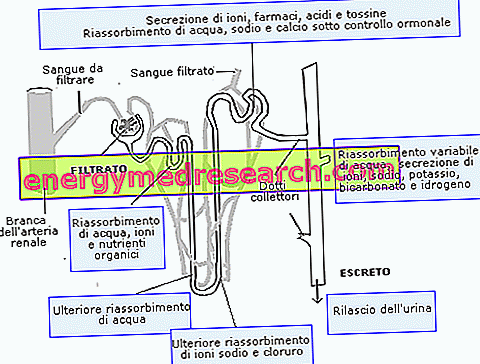Generality
The lice, or pubic lice, are parasitic insects that settle in different hairy areas of the human body, first of all the genital one. Only the hair is excluded from the infestation.
For the transmission of the dishes a very close physical contact is needed, such as a sexual relationship with an infected person; contagion is also possible through the use of contaminated objects, such as clothes and underwear.
The characteristic signs caused by pubic pediculosis occur in the skin and consist of: itching, irritation and the appearance of small blue spots.

Diagnosing flatfish infestation is fairly simple (as long as it is symptomatic): the doctor, in fact, just use a magnifying glass to observe the itchy areas.
Pesticide therapy requires the use of insecticide products, in the form of creams, lotions or shampoos.
What are lobsters?
Lobs, or pubic lice, are parasitic insects that lurk in the genital areas and in other hairy areas of the human body, except the hair.
Their transmission between people takes place after close physical contact with an infected individual or with a contaminated object.
The contamination (or infestation ) of crabs is considered an exclusive parasitic infection of man.
NB: contamination, infestation and parasitic infection are three different terms that define the same concept.
FEATURES OF THE PLATES
How are the lobsters? The lugs measure about 2 millimeters in length, have a rounded shape and have an oval head, equipped with two large antennas.
Their body has hairy growths and can be yellow-gray or dark red.
To the body 3 pairs of legs are attached (therefore 6 legs in all); those of the front pair resemble two large claws and serve to better cling to the hairs of the infected individual.
How does the reproduction of the trays take place? Lobsters are insects, therefore, to reproduce, they lay very small eggs. At the time of laying, the eggs are contained in small pockets, able to remain firmly glued to the hair scattered around the body. The bags are brown on the outside and white on the inside.
What do they eat? The crabs feed on the blood of the infected person. Blood extraction takes place through a small puncture in the skin.
IN WHICH PARTS OF THE BODY GO TO HAVE ANYTHING?
Lobsters can nest in any area of the body covered with hair, except the head.
Generally, they settle in the genital areas, but, in some situations, it is also possible to trace them in the armpits, in the legs, on the chest, on the back, on the abdomen, between the beard and the mustache and finally, even in the eyelashes and eyebrows.
Causes
The plates are "caught" after close physical contact with an infected individual or with a contaminated object.
Extreme closeness is an essential condition for contamination, since the passage of pubic lice from individual to individual (or from object to individual) occurs only by rubbing . The plates, in fact, do not fly and do not jump.
TRANSMISSION FROM PERSON INFECTED TO HEALTHY PERSON
Plate contamination occurs almost always after sexual intercourse, so after a very close physical contact between two people.
The use of condoms does not guarantee effective protection and the widespread parasitic infection with these modalities is considered, in effect, a sexually transmitted disease .
TRANSMISSION DUE TO CONTAMINATED OBJECTS
Sometimes, even objects contaminated by flatfish can act as a vehicle for the spread of parasitic infection.
Usually, the items most at risk of contamination are:
- The clothes
- Bed sheets
- The towels
- Toilet seats
The transmission of the plates that takes place with the aforementioned methods is a very rare event, which is observed in very few occasions.
LIFESPAN CYCLE
When they infest a person, the crabs live for one to three months. During this time, the females present also lay 300 eggs, which hatch in about 6-10 days.
The new generation of plates, in order to ripen and be able to reproduce in turn, needs about 2-3 weeks.
Attention: the plates present on the objects live only 24-48 hours; after which they die for lack of nourishment. This explains the rarity with which the saucers pass from contaminated objects to people.
Symptoms and Complications
Symptoms and signs of plate contamination appear a few weeks after infection (or infestation) and usually consist of:
- Itching at the areas infested by the parasite
- Inflammation and irritation at the infested areas, consequent to frequent scratching
- Traces of a black powder inside the underwear
- Blue spots, spots in the areas where the lobsters nest. These signs are the results of the bites. The most affected points are: the inside of the thigh and the lower part of the abdomen
- Small blood stains on the skin, immediately after the bites of the parasite
Sometimes, it can happen that the plates are asymptomatic or almost, in the sense that they do not involve the appearance of any obvious manifestation, or they do it in a minimal way.
ITCH
Pruritus is the most characteristic expression of flatfish infestation. It affects the areas contaminated by the parasite and is usually very intense.

WHEN TO REFER TO THE DOCTOR?
If the aforementioned signs of the lobsters are evident, it is advisable to contact your general practitioner or a doctor specialized in genitourinary tract infections immediately.
Diagnosis
If infestation is symptomatic, diagnosing flatfish can be simple and immediate; vice versa, it can become problematic when the contamination is asymptomatic.
To detect the presence of parasites and their eggs, an objective examination is required, during which the doctor (preferably a specialist in genitourinary infections) uses a magnifying glass.
EXAMINATION OBJECTIVE
During the physical examination, the doctor uses a magnifying glass to fathom all parts of the body where the plates and / or their eggs may reside.
The plates are recognized, first of all, for the coloring, which is greyish-yellow or dark red, and secondly for the puncture marks, which can be blue (if a few days) or blood-colored (if recent).
Even the eggs are recognizable by their color: they are brown, when they still have to hatch, and white, when they are hatched.
WHY IS IT IMPORTANT TO UNDERSTAND THE CAUSES?
In the presence of a plate infestation, it is important to understand the causes of the disorder, because if this is due to sexual intercourse, further examinations are needed.
These tests consist of a series of precautionary tests, aimed at finding sexually transmitted infections ( STIs ). The presence of an IST, in addition to pubic lice, requires adequate therapy against both problems.
Treatment
To learn more: Pediculosis Cure Medicines
In order to recover from the lice, special insecticidal preparations are needed (also called pesticides in this case), to be applied according to medical prescriptions on the whole body or only on the interested areas. These preparations are available in the form of creams, lotions or shampoos.
If eyelashes and eyebrows are also involved, a specific treatment is needed for these, different from the previous ones and based on Vaseline.
To avoid new infestations, it is good to make sure that no eggs have survived and to wash clothes, sheets and any other potentially contaminable objects (towels, etc.).
PERSONAL CARE
As mentioned earlier, insecticidal preparations are available in creams, lotions or shampoos, to be spread on the body for at least 7-10 days.
For the choice of the best product and the method of use, it is good to ask your doctor or pharmacist for advice.
Warning: adolescents under the age of 18 and women who are pregnant or breast-feeding need insecticides that are suitable for them. On the market, there are creams, lotions and shampoos for patients with different characteristics: it is up to the doctor or pharmacist to indicate the ideal preparation.
How to best use creams, lotions and shampoos? Here are the main tips:
- The insecticide preparation should be applied according to the doctor's instructions. In some cases, it is sufficient to spread the product on the hairy areas affected by the plates; in other cases, a more "invasive" treatment can be used, extended to all areas of the body covered with terminal hairs.
- If the product in use is harmful to the eyes, it should not be applied to the eyebrows and eyelashes. If this recommendation is not taken care of, you should immediately wash your eyes with plenty of water.
- During the treatment period, it is good to wash only if strictly necessary, because the water eliminates the product from the body, obviously neutralizing its effects.
- After each shower, or when washing one of the parts contaminated by the plates, it is advisable to immediately re-apply the insecticide preparation. In general, doctors advise limiting the number of new applications to the minimum necessary (two or three, not more), as a prolonged treatment is not very effective.
- If the plates are resistant to certain pesticide products (a feature made evident by the lack of improvements), you should contact your doctor or pharmacist and request an alternative preparation.
TREATMENT FOR EYELETS AND EYEBROWS
When the lice are spread also at the level of eyelashes or eyebrows, specific products are needed, as the normal preparations used for the rest of the body cause irritation and ocular redness.
These products are ointments based on white or yellow vaseline, which, once applied, "suffocate" the infesting parasites, killing them.
How to correctly apply the ointments for eyelashes and eyebrows:
- Two applications are required per day. It is advisable to act with extreme care and cover all the affected areas well, because this is the only way to permanently kill the parasites.
- Before each new application, care must be taken to clean the eyelashes and eyebrows with a clean tissue. After cleaning, the tissue must be thrown away and not reused.
- The treatment should last at least 8 days.
- If after 8 days, the doctor believes that there are still plates or eggs laid, it is advisable to apply the ointment for another 2 or 3 days.
HOW TO DO IF THE EGGS SURVIVE?
If the eggs survive the first treatment (it is possible, since they are more resistant than the lice), the doctor prescribes a second course of treatment to the patient. The latter generally begins 7 days after the conclusion of the first and has the purpose of eliminating the newly hatched and not yet mature enough to lay other eggs.
Often, at the end of the second treatment there are still open eggs: this, however, must not create worries, because they are the eggs of origin of the second plates killed.
HOW TO WASH THE CLOTHES, THE SHEETS AND EVERY OTHER CONTAMINATED OBJECT?
For a correct and complete disinfestation, it is necessary to wash all the clothes, the sheets and the objects used for personal hygiene (towels, etc.); these, in fact, could contain small plates.
Washing must be carried out in the washing machine at 50 ° C, since only hot water kills all the parasites present.
SIDE EFFECTS
At the skin level and at the ocular level, anti-sole preparations can cause irritation, itching, redness and burning sensation . In each of these cases, the affected area must be washed thoroughly with water and contact your doctor to expose the symptoms you are suffering from and indicate an alternative treatment.
Certain alcohol-based products can alter the color of hair.
INFORM YOUR PARTNERS AND FAMILIES
If the presence of lobsters is subsequent to sexual intercourse, it is good to inform your partner, because you may not be aware of the problem that afflicts you (as you will remember, sometimes the trays are asymptomatic).
Furthermore, it is good practice to inform family members of their problems, because they may have been inadvertently contaminated as well.
When can two infected partners be considered cured?
Two partners can be considered recovered and resume a normal sexual life only after the disinfestation by the lice and the eggs (therefore also the eventual second cycle of cures) has ended successfully.



